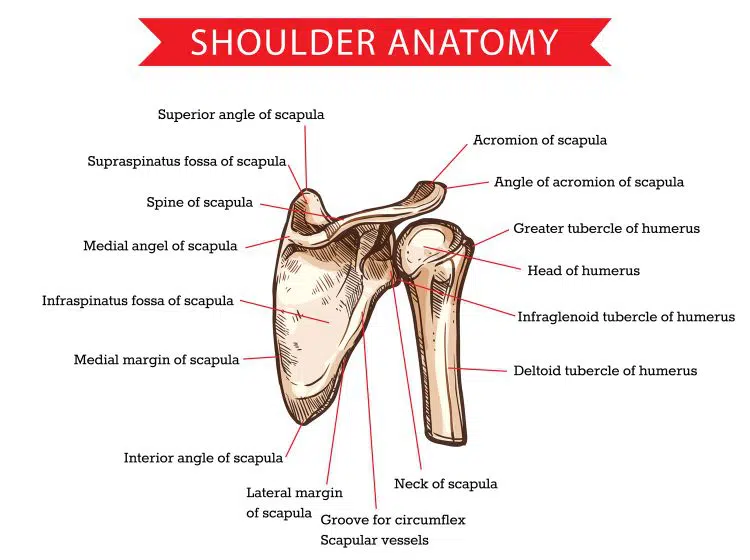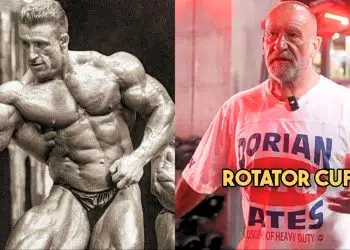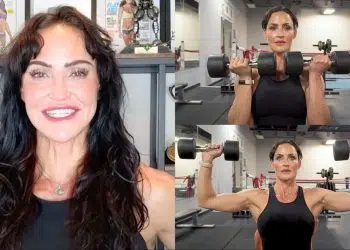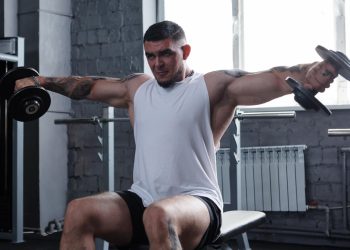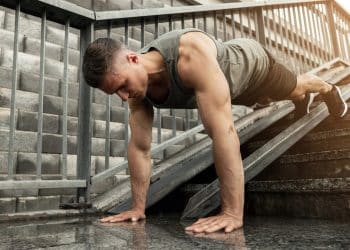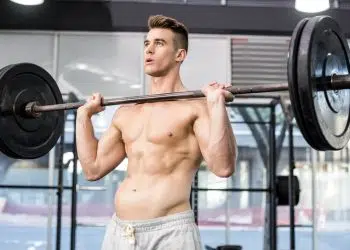As a veteran personal trainer with over 35 years of hands-on experience, I can attest that most people limit their shoulder workouts to a few sets of overhead presses and lateral raises. While the deltoids get a fair amount of work during chest and back workouts, these muscles deserve dedicated attention, just like all the other muscle groups.
The deltoids are the capstone of your physique. They’re responsible for much of your upper body’s width and V-taper and play a critical role in stabilizing your joints and preventing acute and chronic injuries. Neglect your shoulders at your peril!
In this article, I reveal the best shoulder exercises for building muscle and strength and share some tried-and-tested shoulder-building strategies and tips.
About the Experts Behind This Article:
This article by Patrick Dale (ex-Marine), Fitness Volt’s Training Editor and author of several fitness guides, is packed with practical fitness knowledge. The information has been rigorously fact-checked by Tom Miller, CSCS, ensuring accuracy and reliability.
Recent Updates: On May 23, 2024, Fitness Volt’s Senior Editor Vidur Saini (ACE-CPT) revised the list to include only the 15 most effective and proven shoulder exercises. We also added actionable training tips and updated this piece to enhance readability. Level Up Your Fitness: Join our 💪 strong community in Fitness Volt Newsletter. Get daily inspiration, expert-backed workouts, nutrition tips, the latest in strength sports, and the support you need to reach your goals. Subscribe for free!
15 Best Shoulder Exercises
Are you looking for a comprehensive list of the best exercises for building deltoid size and strength? Well, look no further! Here are 15 fantastic shoulder exercises to try!
- Barbell Standing Press (Military Press)
- Barbell Upright Row
- Behind-the-Neck Press
- Seated Dumbbell Press
- Arnold Press
- Shoulder Press Machine
- Dumbbell Lateral Raise
- Dumbbell Front Raise
- Dumbbell Y Raise
- Dumbbell Rear Delt Fly
- Single-Arm Landmine Press
- Face Pulls
- Cable Lateral Raise
- Cable Front Raise
- Cable Rear Delt Fly
Note: Deltoid heads are listed in approximate order of recruitment, with the most active head first.
1. Barbell Standing Press (Military Press)
| Sets & Reps | 3 x 8-12 for hypertrophy, 1-5 for strength |
| Equipment Needed | Barbell, Weight Plates |
| Target Muscles | Anterior and medial deltoids, triceps, upper chest, core |
Before the bench press became the world’s favorite upper body exercise, the barbell standing press was the king of the lifts. Overhead presses build muscle mass and might and are a true test of strength. They’re also one of the best ways to develop massive shoulders.
“I highly recommend wearing a weightlifting belt for this exercise and bracing against it for the concentric phase,” says Saini. “It helps generate more thoracic pressure and keeps the spine safe.”
Steps:
- Stand with your feet shoulder-width apart, knees slightly bent.
- Hold the barbell in the front rack position using a shoulder-width grip. Your forearms should be vertical, elbows below your hands.
- Pull your shoulders back and down, brace your core, and lift your chest.
- Press the bar straight up and overhead to arm’s length.
- Return to the starting position and repeat.
Coach Tips:
- You can also do this exercise seated.
- Do not lean back, as doing so puts unnecessary strain on your lower back and turns what should be a shoulder exercise into more of a chest exercise.
Variations
- Progression: Push Press
- Regression: Seated Dumbbell Press
2. Barbell Upright Row
| Sets & Reps | 3 x 8-12 |
| Equipment Needed | Barbell, Weight Plates |
| Target Muscles | Medial and anterior deltoids, trapezius, biceps |
The barbell upright row is a somewhat controversial exercise, as some people find it causes shoulder pain. This is probably due to the forced medial rotation combined with the use of heavy weights. However, plenty of exercisers can do this movement without issue. If you are one of them, there is no need to stop or avoid barbell upright rows. However, avoid using heavy weights and skip this movement if it bothers your joints.
Saini recommends keeping the bar as close to your body as possible throughout the movement to minimize shoulder joint stress and maximize trap activation. Also, reverse the motion when your upper arms are parallel to the floor.
Steps:
- Hold a barbell with an overhand, shoulder-width grip and stand with your feet about shoulder-width apart, knees slightly bent for balance.
- Pull your shoulders down and back and brace your core. Lift your chest.
- Leading with your elbows, bend your arms and pull the bar up the front of your body to your chest.
- Lower the bar to arm’s length and repeat.
Coach Tips:
- Keep your elbows above your hands at all times.
- You can also do this exercise using dumbbells or a cable machine.
- Adjust the width of your hands to find the most comfortable position and avoid shoulder impingement.
Variations
- Progression: Smith Machine Upright Row
- Regression: Dumbbell Upright Row
3. Behind-the-Neck Press
| Sets & Reps | 3 x 8-12 |
| Equipment Needed | Barbell, Weight Plates |
| Target Muscles | Medial and anterior deltoids, triceps, upper chest |
The behind-the-neck press used to be a staple in bodybuilding training. However, it’s fallen out of favor recently, with many trainers saying it’s bad for your shoulders. The truth is, if you have adequate upper body mobility, you should be able to do this exercise safely and comfortably. However, if it bothers your shoulders, you can do regular shoulder presses instead.
Steps:
- Hold a barbell behind your neck with an overhand, shoulder-width grip.
- Use a false or thumbless grip for comfort. Brace your core and pull your shoulders back and down.
- Press the weight overhead.
- Lower it back down to your neck and repeat.
Coach Tips:
- Do this exercise seated or standing as preferred.
- Avoid craning your head forward. Instead, pull the barbell back.
- Skip this exercise entirely if it bothers your shoulders.
Variations
- Progression: Klokov Press
- Regression: Seated Dumbbell Press
4. Seated Dumbbell Press
| Sets & Reps | 3 x 8-12 for hypertrophy, 1-5 for strength |
| Equipment Needed | Dumbbells, Bench |
| Target Muscles | Anterior and medial deltoids, triceps |
While there is nothing wrong with barbell overhead presses, using dumbbells may be better for some lifters. Using dumbbells means your arms can move independently, which can be more joint-friendly. Plus, you’ll have to work harder to stabilize the weights. So, safer, more comfortable, and potentially more effective? Dumbbells aren’t looking all that dumb now, are they?
Instead of pressing straight up, angle your presses slightly inward to create a stronger contraction in the triceps and front delts, suggests Saini.
Steps:
- Hold a dumbbell in each hand, level with your shoulders, palms facing forward. Brace your core and lift your chest.
- Keeping the weights level, press them up and overhead to arm’s length.
- Lower the weights back to your shoulders and repeat.
Coach Tips:
- You can perform this exercise seated or standing as preferred.
- Use a neutral or palms-in grip for variety.
- Use as large a range of motion as possible without hyperextending your shoulders.
Variations
- Progression: Standing Dumbbell Press
- Regression: Single-Arm Dumbbell Press
5. Arnold Press
| Sets & Reps | 3 x 8-12 |
| Equipment Needed | Dumbbells |
| Target Muscles | Anterior, medial, and posterior deltoids, triceps |
Named after legendary bodybuilder Arnold Schwarzenegger, the Arnold press is an old-school shoulder exercise that’s been popular for many decades. It hits your deltoids in a unique way, which may be just what’s needed to build bigger, more muscular shoulders. It worked for Arnold, who won an incredible seven Mr. Olympia titles, and it could work for you, too.
Steps:
- Hold a dumbbell in each hand and curl them up to your shoulders, palms facing your chest. Pull your shoulders back and down and brace your core.
- Open your elbows and then press the weight overhead while externally rotating your wrists.
- Your palms should face forward at the top.
- Bend your arms and return to the starting position.
Coach Tips:
- This exercise works best with light to moderate weights and medium to high reps.
- Avoid this exercise if it irritates your shoulders.
Variations
- Progression: Single-Arm Barbell Arnold Press
- Regression: Seated Dumbbell Shoulder Press
6. Shoulder Press Machine
| Sets & Reps | 3 x 8-12 for hypertrophy, 1-5 for strength |
| Equipment Needed | Shoulder Press Machine |
| Target Muscles | Anterior and medial deltoids, triceps |
Many so-called functional fitness experts are very quick to throw shade at the shoulder press machine. They say it doesn’t train your muscles and joints as they work naturally. However, if your goal is hypertrophy and you don’t care about functionality, the shoulder press is an excellent option. After all, it allows you to train your deltoids to failure with little risk of injury and without your stabilizer and synergist muscles failing first.
Saini advises experimenting with different grip widths to find the position that best targets your shoulders and feels most comfortable on your joints.
Steps:
- Adjust the seat so that, when you sit on it, the handles are just above shoulder height.
- Take a handle in each hand, brace your core, and pull your shoulders back and down.
- Extend your elbows but stop shy of lockout.
- Return to the starting position.
Coach Tips:
- Rep out to failure, reduce the weight by 10-15%, and then rep out again. This is called a drop set, and an excellent muscle-building strategy.
Variations
- Progression: Seated Dumbbell Press
- Regression: Single-Arm Shoulder Press Machine
7. Dumbbell Lateral Raise
| Sets & Reps | 3 x 10-15 |
| Equipment Needed | Dumbbells |
| Target Muscles | Medial deltoids |
The medial or side deltoids have one major function — arm abduction, which means they lift them out and away from the midline of your body. The medial deltoids give your shoulders their width and, as such, should be a training priority for most people. Lateral raise variations are the only way to isolate this deltoid head.
Steps:
- Hold a dumbbell in each hand, arms by your sides, and palms facing your legs. Your elbows should be slightly bent.
- Raise your arms up and out to your sides until your hands are level with your shoulders.
- Lower the weights back to your legs and repeat.
Coach Tips:
- Avoid raising your arms in front of your body.
- Pause for a split second at the top of each rep to maximize shoulder stimulation.
Variations
- Progression: Cable Lateral Raise
- Regression: Leaning Lateral Raise
8. Dumbbell Front Raise
| Sets & Reps | 3 x 10-15 |
| Equipment Needed | Dumbbells |
| Target Muscles | Anterior deltoids |
Very few exercisers have underdeveloped anterior deltoids. All that pushing and pressing means that this muscle is generally overdeveloped. However, on the off-chance, you’re not one of the masses, dumbbell front raises are one of the best ways to isolate this muscle.
“Slightly lean back as you lift the weights to emphasize the anterior deltoids and minimize the involvement of other muscle groups,” Saini said. “Alternatively, you could perform this exercise lying on an incline bench.”
Steps:
- Hold a dumbbell in each hand, palms facing your thighs.
- Bend your elbows slightly, brace your core, and pull your shoulders back and down.
- Raise one arm forward and up to parallel to the ground.
- Lower the weight back to your thigh and then switch arms.
- Continue alternating for the required number of reps.
Coach Tips:
- You can also raise both arms together.
- Use a weight plate instead of dumbbells.
- Employ a neutral instead of a palms-down grip for variety.
Variations
- Progression: Cable Front Raise
- Regression: Single-Arm Dumbbell Front Raise
9. Dumbbell Y Raise
| Sets & Reps | 3 x 10-15 |
| Equipment Needed | Dumbbells |
| Target Muscles | Anterior, medial, and posterior deltoids |
The dumbbell Y raise is a unique exercise and is typically used in a rehab/prehab setting. However, it’s also an excellent posterior deltoid movement that’s great for posture. Doing it on a bench provides all the lower back support you need, making it lumbar spine-friendly. Go light — this exercise is harder than it looks!
Steps:
- Set an adjustable bench to a 30-degree incline.
- Lie face down on the bench with your head over the edge.
- Hold a dumbbell in each hand. They should be perpendicular to the floor in the starting position.
- Keeping your shoulders down and back, raise your arms forward and up to form a Y-shape.
- Lower the weights and repeat.
Coach Tips:
- Avoid arching your lower back excessively during this exercise, as doing so puts unnecessary stress on your lumbar spine.
- Try both a neutral and pronated grip to see which you prefer.
- Raise your bench on blocks if your hands touch the floor between reps.
Variations
- Progression: Incline Y Raise
- Regression: Lying Y Raise
10. Dumbbell Rear Delt Fly
| Sets & Reps | 3 x 10-15 |
| Equipment Needed | Dumbbells |
| Target Muscles | Posterior deltoids |
The rear deltoids are involved in all shoulder exercises, but their role is often minimal. That’s especially true during most pressing exercises. For this reason, it pays to train them on their own, i.e., in isolation. The dumbbell rear delt fly is a simple and convenient way to do this.
Instead of trying to lift too heavy, focus on retracting the scapula and contracting the target muscle with each rep, says Saini.
Steps:
- Sit on an exercise bench with your legs bent and feet flat.
- Lean forward and rest your chest on your thighs.
- Let your arms hang down outside your legs, palms facing inward.
- Brace your core and pull your shoulders down and back.
- Without bending your elbows, raise the weights up and back until your arms are parallel to the floor.
- Lower your arms and repeat.
Coach Tips:
- Go light; using weights that are too heavy invariably results in cheating and using your lower back.
- You can also do this exercise freestanding, i.e., standing and leaning over from the hips.
- Make this exercise more lower back-friendly by doing it face down on an incline bench.
Variations
- Progression: Cable Rear Delt Fly
- Regression: Reverse Pec Deck Fly
11. Single-Arm Landmine Press
| Sets & Reps | 3 x 8-12 per arm |
| Equipment Needed | Barbell, Landmine Attachment |
| Target Muscles | Anterior and medial deltoids, triceps, core |
A landmine attachment turns a barbell into a versatile, functional training machine you can use to work every muscle group. Landmine presses are especially beneficial, as they hit your shoulders from a unique, joint-friendly angle. No landmine attachment? No problem! Just shove one end of an Olympic barbell into a corner and hold the other. Simple, yet effective!
Steps:
- Load your landmine bar and stand next to it, facing toward the pivot point.
- Grab the sleeve by its end and raise it to shoulder height.
- Adopt a split stance for balance. Pull your shoulder down and back and brace your core.
- Extend your arm forward and up so your elbow is straight but not locked.
- Bend your arm and lower the handle back to your shoulder.
- Continue for the prescribed number of reps, and then switch sides.
Coach Tips:
- Use sow eccentrics to maximize muscle engagement.
- Keep your shoulders square throughout the exercise.
Variations
- Progression: Half-Kneeling Landmine Press
- Regression: Double-Arm Landmine Press
12. Face Pulls
| Sets & Reps | 3 x 15-20 |
| Equipment Needed | Cable Machine, Rope Attachment |
| Target Muscles | Posterior deltoids, rhomboids, middle trapezius |
The face pull is one of the most effective posture exercises you can do. It hits all the muscles across the back of your shoulders, including those all-important rear deltoids. If you care about your posture, shoulder health, or joint stability, this exercise needs a place in your workouts. Do it between sets of horizontal presses to keep your shoulders balanced and strong.
“Instead of pulling the center of the rope directly towards your face, focus on pulling your elbows back and outwards to maximize rear delt and mid-trap activation,” cues Saini.
Steps:
- Attach a rope handle to an adjustable pulley set to chest height.
- Take one end in each hand, extend your arms, and step back to tension the cable. Pull your shoulders back, brace your core, and bend your knees slightly for balance.
- Flex your elbows and pull the handles back to either side of your head.
- Extend your arms and repeat.
Coach Tips:
- Pause at the midpoint of each rep to maximize muscle engagement.
- Lead with your elbows and keep them up to make this exercise as effective as possible.
- Don’t go too heavy, as it will shift the focus to the lats.
Variations
- Progression: Seated Face Pulls
- Regression: Banded Face Pulls
13. Cable Lateral Raise
| Sets & Reps | 3 x 10-15 |
| Equipment Needed | Cable Machine |
| Target Muscles | Medial deltoids |
While there is nothing wrong with dumbbell lateral raises, cables keep constant tension on your muscles, which can produce better hypertrophic results and a more intense pump. This exercise works best as a high-rep finisher, e.g., 20-30 reps, so you really feel the burn.
Steps:
- Attach a D-shaped handle to a low pulley machine. Stand with your side toward the pulley and hold the handle with your opposite hand so the cable runs in front of your hips.
- Stand with your feet hip-width apart, bend your knees slightly, and pull your shoulders back and down. Brace your core.
- Keeping your elbow slightly bent but rigid, raise your arm up and out to the side until it’s parallel to the floor.
- Lower your arm, crossing it in front of your body to increase the range of motion.
- Continue for the desired number of reps.
Coach Tips:
- You can also do this exercise using two cables simultaneously by standing in the center of a cable crossover machine.
- Lead with your elbow to maximize medial deltoid engagement.
- Avoid going too heavy with this exercise. Instead, focus on the movement and keeping tension on the target muscles.
Variations
- Progression: Leaning Away Cable Lateral Raise
- Regression: Dumbbell Lateral Raise
14. Cable Front Raise
| Sets & Reps | 3 x 10-15 |
| Equipment Needed | Cable Machine |
| Target Muscles | Anterior deltoids |
Cable front raises are a very effective, popular anterior deltoid exercise. Like most cable exercises, they keep the target muscles under near-constant tension, producing a deep burn and satisfying pump. If you are looking to isolate your anterior deltoids, this exercise is a great choice.
Steps:
- Attach a straight bar to a low pulley machine. Stand astride the cable with your back to the weight stack.
- Hold the handle in front of your legs using an overhand, shoulder-width grip. Brace your core and pull your shoulders back and down.
- Keeping your elbows slightly bent but rigid, raise the handle forward and up to around head height.
- Lower your arms and repeat.
Coach Tips:
- You can also do this exercise with a rope handle and a neutral grip.
- Lean forward slightly to make this exercise more comfortable and effective.
- Pause at the top of each rep and lower the weight slower than you lift it to maximize muscle engagement.
Variations
- Progression: Leaning Away Cable Front Raise
- Regression: Dumbbell Front Raise
15. Cable Rear Delt Flye
| Sets & Reps | 3 x 15-20 |
| Equipment Needed | Cable Machine |
| Target Muscles | Posterior deltoids |
Dumbbell rear flyes are an effective exercise for isolating the rear deltoids. Saini advises performing this exercise on a functional trainer for a better range of motion.
Steps:
- Stand in the middle of a cable crossover machine. Hold the left cable in your right hand and vice versa so the wires cross in front of your face. Pull your shoulders back and down and brace your core.
- Keeping your elbows slightly bent but rigid, open your arms and pull the cables back at shoulder level.
- Return to the starting position and repeat.
Coach Tips:
- Grip the cables or use D-shaped handles as preferred.
- You can also do this exercise half-kneeling to reduce lower body engagement and prevent cheating.
- This exercise works best with low to moderate weights and medium to high reps.
Variations
- Progression: Leaning Forward Cable Rear Delt Fly (increased range of motion)
- Regression: Dumbbell Rear Delt Fly (less constant tension)
Shoulder Training Guidelines and Workout Tips
You now have access to a huge library of shoulder exercises, each a proven mass and strength builder. However, how you use these exercises is every bit as important as the movements themselves. Even the best exercises won’t produce the results you want if you fail to follow some essential shoulder-building guidelines.
Use the following information to ensure your shoulder workouts are as safe and effective as possible.
1. Start Every Workout with a Warm-Up
The shoulder is a very mobile joint that’s capable of a wide range of movements. Unfortunately, that mobility comes at a cost — stability. As such, the shoulder joint is also very injury-prone, a fact to which many lifters can attest.
Because of this, it is crucial that you warm up your shoulders before training them. Failure to do so can lead to acute and chronic injuries and also make your workout less effective.
A good warm-up should include:
- Pulse raiser: 5 to 10 minutes of light cardio to get your blood pumping and raise your core temperature.
- Joint mobility: exercises designed to increase synovial fluid production to lubricate and nourish your joints.
- Dynamic flexibility: exercises designed to enhance the flexibility of the muscles you’re about to train.
- Ramped sets: a couple of progressively heavier sets of your first few exercises to acclimate your muscles to the workload to come.
While not warming up will save you a few minutes of training time, it could also cost you months of lost progress if you suffer an otherwise avoidable injury. Long story short, never skip your warm-up.
Learn more about warming up for strength training here.
2. Train All Three Deltoid Heads Equally
The deltoids comprise three heads — anterior (front), medial (middle), and posterior (rear). For aesthetics, function, and joint health, all three should be trained pretty evenly.
Most lifters tend to emphasize the anterior head and pay too little attention to the medial and rear heads. Needless to say, this oversight can hurt your long-term progress.
Level Up Your Fitness: Join our 💪 strong community in Fitness Volt Newsletter. Get daily inspiration, expert-backed workouts, nutrition tips, the latest in strength sports, and the support you need to reach your goals. Subscribe for free!
So, whichever shoulder training plan you follow, make sure it works all three heads equally. Remember, too, that the anterior head is also trained every time you work your chest, so you may not need to hit it again in your shoulder workouts. Instead, focus more on your medial and posterior deltoids, as they are most likely to be underdeveloped.
One way to do this is with the 3-2-1 method. Here’s a sample shoulder program that uses this training system:
| # | Exercise | Sets | Reps | Recovery |
| 1 | Face pulls | 3 | 8-12 | 60-90 seconds |
| 2 | Cable lateral raise | 2 | 8-12 | 60-90 seconds |
| 3 | Barbell overhead press | 1 | 8-12 | 60-90 seconds |
This workout emphasizes the posterior deltoids and pays plenty of attention to the medial deltoids but is designed to maintain the anterior deltoids, as they’re probably already sufficiently well-developed.
3. Heavy Compounds, Lighter Isolations
It would be a mistake to use the same rep range and loading parameters for all the exercises in your shoulder workouts, e.g., sets of 8-12. This would entail hitting the same motor units and muscle fibers again and again, which is not usually the most effective way to reach your training goals.
Instead, adopt the heavy compound/light isolation system for variety and effectiveness. This also takes into account how most isolation exercises are hard on your joints when done with overly heavy loads.
For example:
| # | Exercise | Sets | Reps | Recovery |
| 1 | Dumbbell overhead press | 4 | 6-8 | 2 minutes |
| 2 | Bradford press | 3 | 8-10 | 90 seconds |
| 3 | Dumbbell lateral raise | 3 | 12-15 | 60 seconds |
| 4 | Reverse cable fly | 3 | 12-15 | 60 seconds |
| 5 | Cable front raise | 2 | 15-20 | 60 seconds |
It’s also worth noting that while lower reps with heavier loads are best for building absolute strength, studies indicate that you can build muscle with lighter weights and higher reps (5).
4. Use The Right Rep Range for Your Goals
You’ll get better results from your workouts if you spend most of your training time using the most appropriate rep range. The accepted rep ranges by goal are:
- Endurance: 13-20 reps, resting 30-60 seconds between sets
- Hypertrophy: 6-12 reps, resting 60-90 seconds between sets
- Strength: 1-5 reps, resting 3-5 minutes between sets
- Power: 1-5 reps, resting 3-5 minutes between sets
The weight used should cause you to reach muscular failure somewhere within your chosen rep range.
5. Care for Your Shoulders — You’ll Miss Them When They’re Gone!
Shoulder aches and pains are common in bodybuilding, powerlifting, and weightlifting. This makes a lot of sense, given how much abuse these joints must endure. After all, the shoulders are involved in almost every exercise you perform, even those for your legs.
Lifters often train through shoulder pain, hoping what is a dull ache doesn’t turn into something more serious. Unfortunately, those minor niggles often become far worse and much harder to deal with.
So, to make a long story short, take care of your shoulders so they don’t let you down when you need them most. Shoulder pain can be very debilitating, making even the most basic everyday activities like sleeping or brushing your teeth uncomfortable.
Don’t ignore shoulder pain. Instead, get it checked out medically and follow the advice of your doctor or physical therapist.
6. Avoid Training Chest and Shoulders on Consecutive Days
All chest exercises involve your shoulders. Because of this, you should not train chest one day, and your shoulders the next. Chest and shoulder exercises also tend to involve your triceps, creating a second overlap. Instead, separate your chest and shoulder workouts by several days, e.g., Monday for chest and Thursday for shoulders, to allow adequate recovery between workouts.
7. Use a Variety of Training Tools
Maximize your progress by using a range of training tools and methods. For example, you can do front, side, and rear delt raises using dumbbells, cables, suspension trainers (TRX), and resistance bands. Each one affects your muscles slightly differently, and that variety is very good for muscle growth. Some trainers believe that one exercise method is better than the others, and that’s not true. Use them all to make your workouts as productive as possible.
Shoulder Anatomy Basics
While you don’t need an in-depth knowledge of how your shoulders work to train them effectively, understanding a little about their anatomy and physiology should make choosing the right exercises for your goals somewhat easier. With that in mind, here is some basic information about the basic structure and function of your shoulder muscles.
Deltoids
Your deltoids, or delts for short, are your primary shoulder muscles. However, rather than being one single muscle, the deltoids are made up of three sets of fibers, typically referred to as heads. While these three heads function together to control your shoulder joints, you can also emphasize and develop each one in turn (1).
Because of this, it’s critical to know which one you are using so you can train all three equally. Unbalanced shoulder development can affect your appearance, posture, and joint function.
Anterior Deltoid
Located on the front of your shoulder, the anterior deltoid is usually the largest and most well-developed of the three deltoid heads. That’s because, as well as being involved in many shoulder exercises, it’s also worked when you train your chest.
The functions of the anterior deltoid are flexion, horizontal flexion, and medial rotation of the shoulder joint. As such, it’s strongly involved in overhead presses and front raises.
Medial Deltoid
The medial or middle deltoid is located on the sides of your shoulders. This is the deltoid head that gives your shoulders their width. The medial deltoids are responsible for the abduction of your shoulder joint, meaning they raise your arm up and away from the midline of your body, e.g., during dumbbell lateral/side raises.
Posterior Deltoid
Located on the back of your shoulders, the posterior or rear deltoid is usually the most neglected and underdeveloped of the three deltoid heads. As such, it should be a training priority for most lifters. Not only will building your rear deltoids improve your physique, but it will also lead to more stable, healthier joints and better posture.
The functions of the posterior deltoids are extension, horizontal extension, and external rotation of the shoulder joints. They’re primarily trained during wide grip horizontal rows, such as face pulls, band pull-aparts, and rear delt flys.
Rotator Cuff
While you can’t see your rotator cuff, this group of four small muscles works alongside your deltoids and all your other upper body muscles. The rotator cuff aids in controlling the movements of your shoulder joint and often acts as a stabilizer. The four rotator cuff muscles are the supraspinatus, infraspinatus, teres minor, and subscapularis (2).
While these muscles are considerably smaller than the deltoids, they are no less important. A lot of shoulder injuries result from a weak or damaged rotator cuff.
The rotator cuff is involved in all shoulder and upper body exercises, and some movements target it more directly, several of which are described below.
FAQs
1. How often should I train my shoulders?
Shoulder training frequency depends on your experience and goals. Beginners may find training shoulders once a week is enough, while more advanced lifters may benefit from two sessions per week. If you do decide to hit your delts twice weekly, one approach might be to include one strength workout and another one hypertrophy in your plan.
2. Can you build bigger shoulders with bodyweight exercises?
You certainly can! Exercises like handstand push-ups, pike push-ups, and wall walks are very effective for building shoulder strength and size. The key is to focus on progressive overload, which means gradually increasing your rep count or the difficulty of these exercises as you get stronger.
3. Can I train my shoulders if I have shoulder pain?
While some exercises may worsen shoulder pain, there are alternatives like machine shoulder presses and cable lateral raises that are generally more joint-friendly. However, if you have persistent or severe pain, it’s advisable to consult a healthcare provider before continuing your training regimen, as your workout could be making things worse, delaying your recovery.
4. What’s the best way to avoid shoulder injuries?
Proper warm-up, good technique, progressive overload, and adequate rest are all vital to avoid shoulder injuries. Incorporate mobility and flexibility exercises into your routine and listen to your body. If a particular movement causes discomfort, consider alternative exercises that target the same muscle groups but are less irritating.
5. How can I break through a shoulder training plateau?
If you find your progress stalling, it’s probably time to upgrade your training program. This could mean changing the exercises, rep ranges, or even the type of resistance used. Periodization, which involves cycling through different training phases, can also be effective in overcoming plateaus. You could also consider adding an intensity-boosting training system to your workouts, which could help blast you out of your current progress rut.
6. Are dumbbells or barbells better for shoulder training?
Barbells and dumbbells both have their benefits. Dumbbells allow for a greater range of motion and can help correct muscle imbalances. In contrast, barbells allow you to lift heavier weights, which is beneficial for building strength. A balanced shoulder training program would ideally incorporate both.
Don’t forget you can use machines, resistance bands, and bodyweight exercises, too. There is no reason to adopt and stick with a single training modality when they all offer benefits.
Closing Thoughts
Many lifters leave their shoulder training to chance, hoping that a few sets of presses and lateral raises are all they need to develop strong, stable, muscular delts. Needless to say, such an approach is seldom successful.
So, use the information in this article to create balanced, effective shoulder workouts that work each deltoid head equally. This will not only give you better-looking shoulders, but they’ll also be healthier and less prone to injury.
Remember, though, that your shoulders are a very hardworking joint, and shoulder pain can affect every exercise you do, not to mention your ability to carry out everyday tasks, so make sure you treat them with respect and avoid training through pain.
Train hard but also train smart to build shoulders you can be proud of and that last a lifetime!
Learn More on on Shoulder Exercises:
The benefits of prioritizing shoulder exercises are vast and extend well beyond this article. With a myriad of exercises specifically designed for shoulder strengthening and numerous ways to integrate them into your workout routine, your next insightful read awaits below:
- Best Rear Deltoid Exercises
- Essential Cable Shoulder Exercises
- Best Front Delt Exercises
- Best Side Delt Exercises
- Build Bigger Shoulders: Overhead Press Hypertrophy
- Overhead Barbell Press Variations
- 13 Ways to Avoid Shoulder Pain
References:
- Sakoma Y, Sano H, Shinozaki N, Itoigawa Y, Yamamoto N, Ozaki T, Itoi E. Anatomical and functional segments of the deltoid muscle. J Anat. 2011 Feb;218(2):185-90. doi: 10.1111/j.1469-7580.2010.01325.x. Epub 2010 Nov 30. PMID: 21118198; PMCID: PMC3042752.
- Maruvada S, Madrazo-Ibarra A, Varacallo M. Anatomy, Rotator Cuff. 2023 Mar 27. In: StatPearls [Internet]. Treasure Island (FL): StatPearls Publishing; 2023 Jan–. PMID: 28722874.
- Błażkiewicz M, Hadamus A. The Effect of the Weight and Type of Equipment on Shoulder and Back Muscle Activity in Surface Electromyography during the Overhead Press-Preliminary Report. Sensors (Basel). 2022 Dec 13;22(24):9762. doi: 10.3390/s22249762. PMID: 36560129; PMCID: PMC9781216.
- Kotarsky CJ, Christensen BK, Miller JS, Hackney KJ. Effect of Progressive Calisthenic Push-up Training on Muscle Strength and Thickness. J Strength Cond Res. 2018 Mar;32(3):651-659. doi: 10.1519/JSC.0000000000002345. PMID: 29466268.
- Lasevicius T, Ugrinowitsch C, Schoenfeld BJ, Roschel H, Tavares LD, De Souza EO, Laurentino G, Tricoli V. Effects of different intensities of resistance training with equated volume load on muscle strength and hypertrophy. Eur J Sport Sci. 2018 Jul;18(6):772-780. doi: 10.1080/17461391.2018.1450898. Epub 2018 Mar 22. PMID: 29564973.
Interested in measuring your progress? Check out our strength standards for Bench Press, Push Ups, Face Pull, and more.

